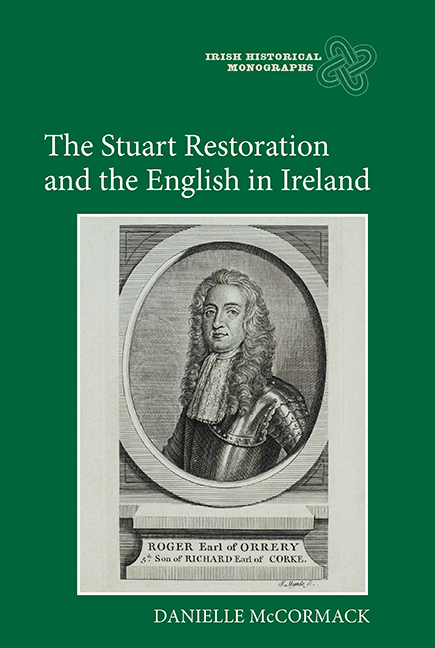Book contents
- Frontmatter
- Contents
- Miscellaneous Frontmatter
- Acknowledgements
- List of abbreviations and conventions
- Introduction
- 1 The political and mental map of 1660s Ireland
- 2 Stuart restoration and the beginnings of Protestant discontent
- 3 Roger Boyle, earl of Orrery, and the evolution of English Protestant identity in Ireland
- 4 Moral and rhetorical challenges to Protestant power
- 5 Charles II and his ministers in Ireland
- 6 The court of claims, popery and Stuart authority
- Conclusion
- Bibliography
- Index
1 - The political and mental map of 1660s Ireland
Published online by Cambridge University Press: 05 July 2016
- Frontmatter
- Contents
- Miscellaneous Frontmatter
- Acknowledgements
- List of abbreviations and conventions
- Introduction
- 1 The political and mental map of 1660s Ireland
- 2 Stuart restoration and the beginnings of Protestant discontent
- 3 Roger Boyle, earl of Orrery, and the evolution of English Protestant identity in Ireland
- 4 Moral and rhetorical challenges to Protestant power
- 5 Charles II and his ministers in Ireland
- 6 The court of claims, popery and Stuart authority
- Conclusion
- Bibliography
- Index
Summary
By 1659, Ireland was in a relatively stable political and economic situation, following the turmoil that had engulfed it between 1641 and 1652. The rebellion of Gaelic landlords in Ulster in 1641 had unleashed popular resentment against the policies of plantation in Ireland. Throughout the 1640s, the king, represented by his lord deputy, James Butler, marquess of Ormond, struggled to assert his authority there. His position was challenged by the Catholic Confederation of Kilkenny, established for the restoration of social order and to improve the position of Catholics in the kingdom. Monarchy was further challenged in Ireland by the presence in Ulster of a Scottish Covenanting army and by the vacillation of Protestants of English origin, who looked to the English parliament to quell the Catholic threat to their position. The matter of suppression of the Irish Catholic rebellion came to be of importance in domestic English politics. Ireland became a site of contention between king and parliament as each struggled to assert control over the waging of war against Irish rebels there. With the king absent in Scotland, management of the suppression of the Irish rebellion helped to consolidate parliament's role as an effective government. The conquest of Ireland initiated by Oliver Cromwell in 1649 and accomplished by 1652 marked the vanquishing of the Catholic stake in Ireland while ushering in a period of fusion between the agendas of Ireland's Protestants and the latest English programme for the country, a programme that was in fact the culmination of many earlier, frustrated plans to anglicise Ireland.
The administrative basis for the Cromwellian settlement of Ireland was laid by the 1642 Adventurers Act, which encouraged investors to subscribe money to a planned conquest of Ireland. Land would be granted to investors in return for this subscription. Adventurers were to expect a return of one acre of land in Ulster for each shilling invested. Six shillings was the price of an acre of land in Connacht, while ten shillings and twelve shillings were the respective values of an acre of land in Munster and Leinster. The Doubling Ordinance of 1643 enabled adventurers to double their expected return by subscribing an additional quarter of the sum originally laid out. However, adventurers did not invest in land in a particular province, and they had no control over the region in which their lot might fall.
- Type
- Chapter
- Information
- The Stuart Restoration and the English in Ireland , pp. 5 - 29Publisher: Boydell & BrewerPrint publication year: 2016



